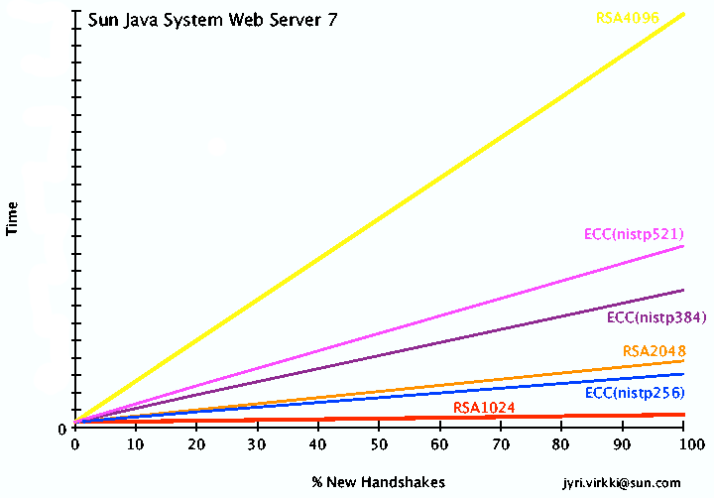As I have mentioned earlier, the upcoming Web Server 7 will include ECC support.
While relative performance predictions comparing RSA and ECC are available in various papers, I was curious to get a glimpse into how it performed in practice in our web server. So, I did a few runs and graphed the results below.
The X axis corresponds to the percentage of new TLS session handshakes during the run (several thousand requests). If a single client were issuing all the requests it would perform one handshake during the initial connection and reuse that TLS session for all remaining requests. As one could expect, in this case there isn’t really any difference between the algorithms and keysizes since no matter how fast or slow the very first connection was, it is a minute portion of the total runtime. At the other extreme is the case of 100% new handshakes – every request comes from a new client and that client doesn’t reuse the session again.
Neither of these extremes is realistic for web server traffic, of course. Normal usage patterns will fall somewhere in between.
The following table shows approximate equivalency in strength between RSA and ECC, to provide some context to the results above:
| RSA | ECC |
|---|---|
| 1024 | 160 |
| 2048 | 224 |
| 3072 | 256 |
| 7680 | 384 |
| 15360 | 521 |
So, we can see that while 1024 bit RSA isn’t too much of a performance burden even if our server experiences lots of new handshakes, things look quite different at 2048 bit RSA. And 4096 bit RSA is nearly off the chart. On the other hand, while ECC with the nistp256 curve is roughly equivalent in strength to 3072 bit RSA, it performed faster than 2048 bit RSA. Not bad.
The higher key length won’t be so interesting for years to come (barring unforeseen advances) but it is interesting to note how the performance compares as keysizes grow. ECC with nistp521 is substantially faster then 4096 bit RSA, even though it is roughly equivalent to 15360 bit RSA in strength!
Note: I ran the web server on a single CPU single core server for these tests. Such machines are hard to come by these days.. so I ran it on a very old box I had sitting around. The absolute numbers aren’t very interesting so I left the Y axis numbering out.

